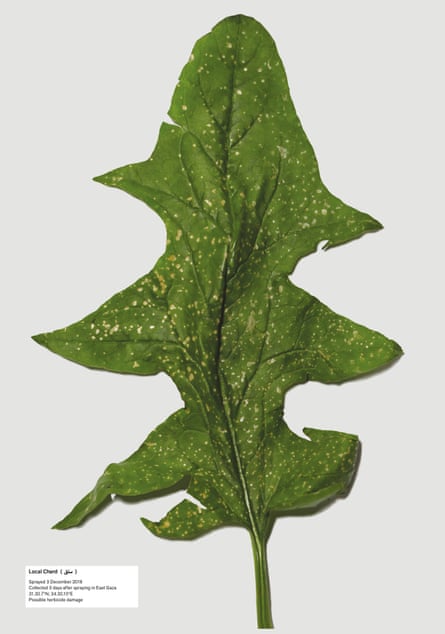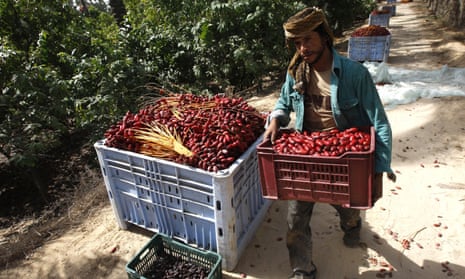Israeli aircraft spraying herbicide beside the buffer zone along the Gaza strip is directly affecting the livelihoods of Palestinians in violation of international standards, a new report claims.
The study tracked the drift of the herbicides on to the Gazan side and concluded it was killing agricultural crops and causing “unpredictable and uncontrollable damage”, according to the report’s main researcher.
The report also concluded the spray is reaching more than 300 metres (980ft) into Gaza.
The work was undertaken by Forensic Architecture, a research agency based at Goldsmiths, University of London, which spent 16 months investigating the potential effects of the spraying.
The report’s lead researcher said that in the last five years Israeli planes have sprayed herbicide more than 30 times on the Israeli side of the buffer zone with Gaza, which is controlled by Hamas, designated a terror group by the European Union.
The Israeli Ministry of Defense told the Guardian the spraying is necessary for security reasons, is “conducted only over the territory of the State of Israel” and is supervised by certified professionals.
“The defence establishment conducts weed control in which the material is sprayed from the air for operational purposes, among them removing potential cover for terror elements, which may threaten the citizens of the State of Israel, particularly the communities living adjacent to the Gaza border, as well as [Israel Defense Forces] troops,” the ministry said in a statement.

Farmers living and working in these areas, however, have long claimed that their crops and livelihoods suffer as a result.
Using a video taken by Gisha, a Tel Aviv-based freedom of movement NGO, Forensic Architecture reconstructed the drift of the herbicide from a plane with the help of a fluid dynamics expert.
It also analysed leaf samples, interviewed farmers and used satellite imagery to map the effects of the spraying. The resulting video report will be presented on Sunday, 21 July in Ramallah.
It says harmful concentrations of the spray that surpass EU standards landed in areas where farmers had recorded damage in the past.

“If you generalise this single spraying event in Khan Yunis on April 5th [2017] to the rest of the border you see something very similar,” said the researcher, who requested anonymity to protect their access.
“You see that there’s a protracted and continuous loss of greenness along the border that has over time flattened it and that isn’t recovering. It’s a piece of land that through bombings and the bulldozings and twice-a-year herbicidal spraying is becoming a barren and scorched dead zone.”
Israel and Hamas have fought three wars since 2007 when Hamas seized control of the coastal enclave and Israel and Egypt imposed a land and sea blockade.
Previous reports by the Israeli website +972 and Haaretz newspaper, along with freedom of information requests from Gisha, have unearthed similar findings about damage to the land on the Gazan side.
The Forensic Architecture report provides further confirmation that the herbicide spraying has caused “unpredictable and uncontrollable damage” on the Gaza side, according to their researcher.
“What was so significant from the Forensic Architecture [report] was that they show that the main effect of the spraying is inside of Gaza,” said Muna Haddad, an advocate with Gisha.
Gisha, along with Adalah, a Palestinian rights group based in Haifa, and Al Mezan , a Gaza-based human rights group, have petitioned the Israeli military for compensation for farmers in Gaza who say they have lost crops due to the spraying.
Israeli authorities have rejected the petition.
However, they did provide compensation to an Israeli agricultural town, Nahal Oz, near the buffer zone in 2015, after farmers sued because they lost crops after a spraying.
The Israeli Ministry of Defense did not respond to a specific question regarding wind direction, but said that the spraying is certified by professionals.
“It is carried out by companies specialised in the field, in accordance with the law,” the ministry said in a statement.
“The materials have been approved by the Ministry of Agriculture, and are used in agricultural fields across Israel, as well as by other countries. The process is conducted and supervised by certified professionals.”
This spring was the first time in five years that Israeli Defense Forces did not spray the border area and farmers in the affected areas reported better farming conditions, according to human rights groups.
Gisha, along with Adalah and Al Mezan, said that if and when the next spraying occurs, they will use Forensic Architecture’s findings to petition Israel to stop the practice or to mitigate the damage, such as providing compensation or advance notice so that farmers can cover their crops.
“It’s not enough that you [the Israeli military] claim that the spraying is inside Israel,” said Haddad. “No, you can’t take any measures that harm the basic needs and health and life of people there.”








